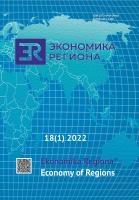Влияние межтерриториальной связанности на развитие экономического пространства регионов
Impact of Inter-territorial Cohesion on the Development of Regional Economic Spaces
Author(s): Irina Valentinovna Danilova, Irina Petrovna Savelyeva, Aleksandr V. RezepinSubject(s): Economy, National Economy
Published by: Институт экономики Уральского отделения Российской академии наук
Keywords: regional economic development; spatial cohesion; economic cohesion of municipalities; types of economic development; economic space; factors of regional development; spatial autocorrelation;
Summary/Abstract: Spatial organisation of the regional economy and spatial development of Russia have been actively discussed in the academic community. However, this discussion did not resolve the issues concerning the characteristics of spatial economic systems and the impact of inter-territorial cohesion on regional economic space. The study examines intra-regional cohesion of economic spaces as the interdependence of economic growth parameters observed in municipalities. Additionally, types of cohesion differently affecting economic growth in various intra-regional local zones are identified. Assessment of intra-regional cohesion based on data from municipalities of single-industry regions (Krasnoyarsk krai, Vologda, Lipetsk and Chelyabinsk oblasts) for the period 2017–2019 revealed three types of territories. First are municipalities characterised by the interdependent growth, positive agglomeration effects and the ability to integrate into value chains. Territories known for passionate development, producing independent economic growth, are able to strengthen their own economic opportunities and absorb the neighbouring potential. Sub-passionate development is characteristic for municipalities that, despite the positive production dynamics in neighbouring territories, cannot produce independent economic growth; their spatial and economic relations with other municipal formations are insufficient. The research results show that municipalities characterised by passionate development demonstrate higher growth rates of the real volume of produced and shipped goods and the real investment. Such parameters indicate the current leading positions of these territories, as well as the availability of opportunities for sustainable progressive development. Based on comparative analysis of zones with different growth types and agglomeration formations in single-industry regions, the study distinguish passionate, mutually reinforcing and mixed models of agglomerated spaces. It was proposed to determine the priorities of agglomeration policies in accordance with the types of inter-territorial cohesion. The findings can be used by government bodies for strategic management of regional spatial development. The obtained results determine the prospects for analysing other parameters of inter-territorial cohesion and assessing its impact on spatial economic development.
Journal: Экономика региона
- Issue Year: 18/2022
- Issue No: 1
- Page Range: 31-48
- Page Count: 18
- Language: Russian

